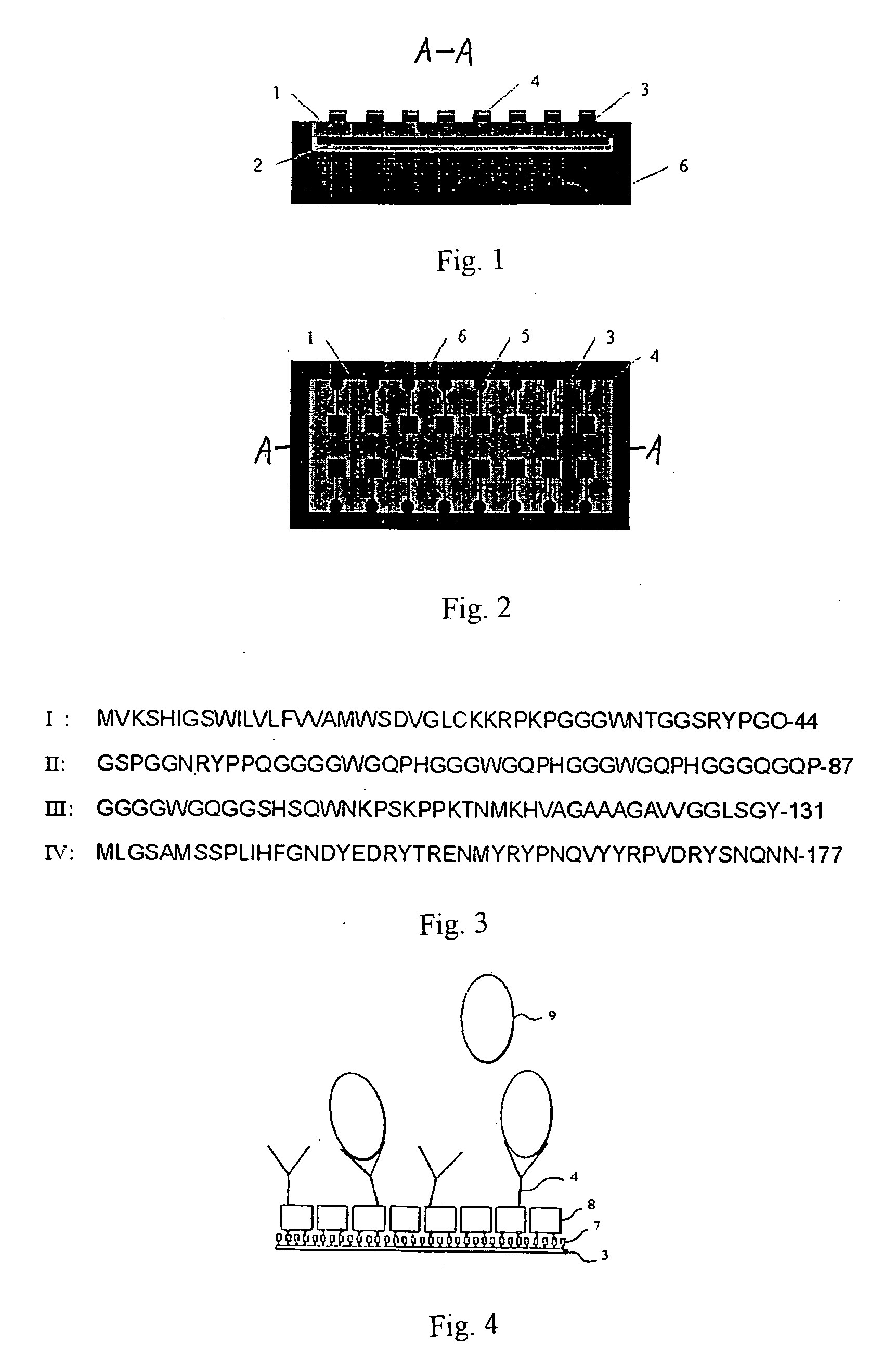Piezoelectric bio-chip for detecting pathogen of mad cow disease and thereon preparation
a biochip and pathogen technology, applied in the field of animal inspection and quarantine devices, can solve the problems of increasing panic and concern, complex detection devices, and high cost, and achieve the effects of no need for labeling, accurate and rapid detection of bse pathogens, and simple operation
- Summary
- Abstract
- Description
- Claims
- Application Information
AI Technical Summary
Benefits of technology
Problems solved by technology
Method used
Image
Examples
example 1
[0034] One piezoelectric biochip for the detection of the BSE pathogen according to the present invention.
[0035] In this example, the piezoelectric chip 1 was a chip of quartz crystal which was 100 micrometers (μm) thick, both the microelectrode film 3 and its pin 5 were gold film 200 nanometers (nm) thick, and the piezoelectric chip 1 and the microelectrode 3 were in a shape of quadrangle. The antibody array 4 consisted of four PrP antibodies against normal or abnormal PrPs with N-terminal amino acid sequence identified in I or II, respectively. The support 6 was made of ceramic. The antibodies 4 were immobilized on the microelectrodes 3 by a cross-linking process with a fixing agent, and the thickness of the PrP antibodies was 100-150 nm. The fixing agent consisted of 4% paraformaldehyde, 25% glutaraldehyde, 10% phosphate buffer solution of pH 6-8, and a balance of water. The immobilization temperature was 4° C. and the immobilization period of time was 8 hours. This example of t...
example 2
[0036] One piezoelectric biochip for the detection of the BSE pathogen according to the present invention.
[0037] In this example, the piezoelectric chip 1 was a chip of quartz crystal which was 80 micrometers (μm) thick, both the microelectrode film 3 and its pin 5 were silver film 150 nanometers (nm) thick, and the piezoelectric chip 1 and the microelectrode 3 were in a shape of round. The antibody array 4 consisted of six PrP antibodies against normal or abnormal PrPs with N-terminal amino acid sequence identified in I, II, or III, respectively. The support 6 was made of plastic. The antibodies 4 were immobilized on the microelectrodes 3 by a cross-linking process with a fixing agent, and the thickness of the PrP antibodies was 100-150 nm. The fixing agent consisted of 2% ethyl-dimethylaminopropylcarboimide hydrochloride, 25% glutaraldehyde, 10% phosphate buffer solution of pH 6-8, and a balance of water. The immobilization temperature was 15° C. and the immobilization period of ...
example 3
[0038] One piezoelectric biochip for the detection of the BSE pathogen according to the present invention
[0039] In this example, the piezoelectric chip 1 was a piezoelectric poly(vinylidene fluoride) chip which was 200 micrometers (μm) thick, both the microelectrode film 3 and its pin 5 were gold film 100 nanometers (nm) thick, and the piezoelectric chip 1 and the microelectrode 3 were in a shape of quadrangle. The antibody array 4 consisted of eight PrP antibodies against normal or abnormal PrPs with N-terminal amino acid sequence identified in I, II, III, or IV, respectively. The support 6 was made of plastic. The antibodies 4 were immobilized on the microelectrodes 3 by self-assembly of biotin and avidin, and the thickness of the PrP antibodies was 100-500 nm. The immobilization temperature was 25° C. and the immobilization period of time was 2 hours. This example of the piezoelectric biochip according to the present invention was useful in detecting qualitatively and analyzing ...
PUM
 Login to View More
Login to View More Abstract
Description
Claims
Application Information
 Login to View More
Login to View More - R&D
- Intellectual Property
- Life Sciences
- Materials
- Tech Scout
- Unparalleled Data Quality
- Higher Quality Content
- 60% Fewer Hallucinations
Browse by: Latest US Patents, China's latest patents, Technical Efficacy Thesaurus, Application Domain, Technology Topic, Popular Technical Reports.
© 2025 PatSnap. All rights reserved.Legal|Privacy policy|Modern Slavery Act Transparency Statement|Sitemap|About US| Contact US: help@patsnap.com

